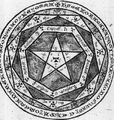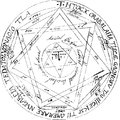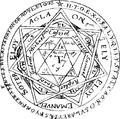Sigillum Dei
The Sigillum Dei ('Seal of God', also signum dei vivi 'Sign of the living God', and since John Dee called the Sigillum Dei Æmeth ) is a diagram that has been attested in magical literature since the late Middle Ages and consists of two circles, a pentagram and three Is composed of heptagons and is inscribed with the names of God and his angels. It is an amulet ( amuletum ) with magical and theurgic function, which helps in the ars magica inaugurated master ( magister ) by explaining one of the oldest sources ( Liber iuratus ) power over all creatures, except the Archangel , win and should be able to attain the vision of God ( visio beatifica ), otherwise reserved only for the blessed and angels, during his lifetime .
Illustrations
middle Ages
Liber iuratus
Probably the oldest known text with a description and illustration of the Sigillum Dei is the Liber iuratus (also Liber sacratus , Liber sacer sive iuratus , English Sworne Booke ), which has been handed down in manuscripts from the time since the 14th century History of origin is attributed to a Honorius, Magister of Thebes and son of Euclid , and possibly as early as the first half of the 13th century, but more likely not before the time of Pope John XXII. (1316–1334) was created.
The description of the seal in the Liber iuratus initially relates the dimensions of the surrounding circular band to common symbol numbers of the Christian tradition:
- “First make a circle three fingers in diameter because of the three cross-nails of the Lord, or five fingers because of the five wounds of Christ, or seven because of the seven sacraments, or nine because of the nine ordinances of the angels; however, it is usually five fingers. Then make a second within this circle, which is two grains away from the first because of the two tables of the Law of Moses, or three grains because of the persons of the Trinity. "
The circular band created in this way then has a small cross at its apex and, starting from this, 72 Latin letters from left to right, which vary in tradition (MS Sloane 3853): h, t, o, e, x, o, r, a , b, a, s, la, y, q, c, i, y, s, t, a, l, g, a, a, o, n, o, s, v, l, a, r, y , c, e, k, s, p, f, y, o, m, e, n, e, a, u, a, r, e, l, a, t, e, d, a, t, o , n, o, n, a, o, y, l, e, p, o, t, m, a) and in total the Schem hamephorasch , the ineffable name of God ("magnum nomen Domini Semenphoras 72 licterarum") should: a clear link to a Jewish tradition that has existed since the 13th / 14th Century becomes tangible in other Latin texts.
Next, a pentagram is inscribed on the circular ribbon, in the center of which a Greek rope is inscribed, this surrounded by the five letters of the divine names " El " and "Ely", as well as five other pairs of letters (lx, al, la, lc, um) to be entered in the triangular segments of the pentagram.
A first heptagon is to be drawn around the pentagon in such a way that its uppermost side touches the top of the pentagram in its center, and the sides of this heptagon are to be inscribed with the names of seven angels or archangels (Cafziel, Satquiel, Amael , Raphael , Anael, Michael , Gabriel ).
A second and a third are to be drawn around this first heptagon, the description of which is difficult to understand and has been interpreted differently in the handwritten illustrations, but in any case results in further segments that are to be provided with crosses in seven corner points and with two further rows of Names of God are to be inscribed: a first series of seven names of God, each broken down into three syllables or components and with these spatially related to the initial and final syllables of the previous angel names as well as to intersections or corner points of the figure, namely la-ya- ly (to Cafziel), na-ra-th (to Satquiel), ly-bar-re (to Raphael), ly-ba-res (to Michael), (e) t-ly-alg (to Samael), ve -h-am (to Anael), and y-al-gal (to Gabriel); Furthermore, in subsegments and spaces, seven more Vos, Duynas, Gyram, Gram, Aysaram, Alpha and Omega, a third row El, On, El, On, El, On, Omega, as additions to the entered crosses the four letters a, g , a, l and finally a series of five divine names Ely, Eloy, Christ, Sother and Adonay.
To color the seal, the Liber iuratus states that usually the pentagram is colored red with yellow areas, the first heptagon blue, the second yellow, the third purple and the circles black, furthermore the area between the circles yellow and all other areas green but this is also handled differently in magical operations if instead blood is drawn from moles, pigeons, hoopoes, bats or other animals on virgin parchment of beef, horse or deer.
Clavicula Salomonis
Witnesses of the Sigillum Dei which differ in shape due to the use of a hexa instead of a pentagram are known from the tradition of the Clavicula Salomonis , namely from an Italian arrangement in the collection of Heimann Joseph Michael in the Bodleian Library (Ms. Michael 276), and one Copy of the clavicle made by John Aubrey in 1674 , also in the Bodleian Library (MS. Aubrey 24).
Early modern age
One of the two oldest surviving manuscripts of the Liber iuratus , manuscript no.313 from the collection of Hans Sloane in the British Museum from the end of the 14th or beginning of the 15th century , was temporarily in the possession of the mathematician and magical experimenter John Dee , in whose Mysteriorum libri quinti, or, Five books of mystical exercises (1581–1583) the Sigillum Dei then played a central role and the suffix Sigillum Dei: Emeth or Æmeth ("truth"), one of the 72 names of God from the Kabbalistic tradition, was expanded.
With John Dee, who received the authoritative description of the seal in 1582 from his medium and collaborator Edward Kelley and only used written sources for their better understanding, this scholarly and antiquarian interest ultimately remained subordinate to the purpose of practical application. In the case of Athanasius Kircher, on the other hand, who devoted a detailed interpretation to the Sigillum Dei in his Oedipus aegyptiacus , the rejection of magical practice was combined with the learned endeavor to recognize and separate the Christian, Jewish, Arab-Muslim and pagan parts. For example, the letters inscribed in the triangular segments of the pentagram, in Liber iuratus lx, al, la, lc, um, in Kircher, however, yl, al, le, al, um, are according to Kircher as Arabic la, alla, ella, alla "non est Deus nisi Deus ”, ( Schahāda : lā ilāh [a] illā ʿllāh [u]) with a final formula to interpret for Mahumet rassul alla , so that the demon slipped the seduced magician as a supposedly Christian formula of praise to Allah and Muhammad.
Remarks
- ↑ Gösta Hedegård: Liber iuratus Honorii: A Critical Edition of the Latin version of Sworn Book of Honorius , institutions for Klas Siska Språk, Stockholm 2002 (= Acta Universitatis Stockholmiensis, Studia Latina Stockholmiensia, 48); see. also Jean Patrice Boudet: Magie théurgique, angéologie, et vision béatifique dans le Liber sacratus sive iuratus attribué à Honorius de Thèbes , in: Mélanges de l'École française de Rome: Moyen-Âge 114,2 (2002), p. 851– 890, text pp. 871-890; The English editions of Daniel J. Driscoll, The Sworn Book of Honorius the Magician , Heptangle Press, Gillette (NJ) 1977, 2nd ed. 1983, and by Joseph H. Peterson at http: // www should be used with caution .esotericarchives.com / juratus / juratus.htm
- ^ Robert Mathiesen, A Thirteenth Century Ritual to Attain the Beatific Vision from the Sworn Book of Honorius of Thebes , in: Claire Fangier (Ed.), Conjuring Spirits: Texts and Traditions of Ritual Magic , Sutton, Stroud 1998, pp. 144ff. , P. 146f.
- ^ Jean Patrice Boudet, Magie théurgique ... (2002), pp. 858f.
- ↑ Boudet, Magie théurgique ... (2002), p. 876: "Primo fac unum circulum, cujus diameter sit trium digitorum propter tres clavos Domini, vel 5 propter quinque plagas, vel 7 propter 7 sacramenta, vel 9 propter 9 ordines angelorum , sed communiter 5 digitorum fieri solet. Deinde infra illum circulum, fac alium circulum a primo distantem duobus granis ordei propter duas tabulas Moysi vel distantem a primo tribus granis propter Trinitatem personarum. "
- ↑ Jean Patrice Boudet, Magie théurgique ... (2002), p. 863 f.
- ↑ Deborah E. Harkness: John Dee's Conversations with Angels: Cabala, Alchemy, and the End of Nature , Cambridge University Press, Cambridge et al. a. 1999, p. 35ff.
- ↑ Athanasius Kircher: Oedipi Aegyptiaci Tomi Secundi Pars Altera , Vitale Mascardo, Rome 1653, class. IX (Magia Hieroglyphica), cap. VIII, ram. II, § IV (Amuleti alterius Cabalistici heptagoni interpretatio), pp. 479-481, ECHO online version , HTML rendering by Joseph H. Peterson






